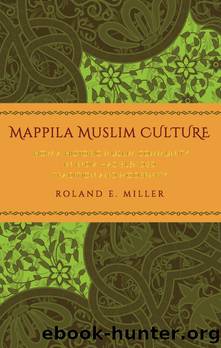Mappila Muslim Culture by Roland E. Miller

Author:Roland E. Miller
Language: eng
Format: epub
Publisher: State University of New York Press
Published: 2015-06-15T00:00:00+00:00
Caste-Like Groups
The Hindu caste system is the dominant background for the discussion of the many Muslim social groups in India, and Malayalam society today is still noted for its strong caste alignments. It would be unreasonable to expect that Mappila culture would remain unaffected by this environment, and it is remarkable that the influence was generally so benign. Mappilas tended to resist groupismâone of the main factors in the conversion to Islam in interior Malabar was the reputation of Muslim social equality. Nevertheless, caste-like groups are also present among Mappilas. They are not castes in that they do not carry the same social implications that Hindu castes do, but they are caste-like in that they constitute distinct associations and some may even observe endogamous marriage practices.
Some of the groups are related to functions and continue the craft guild heritage that lies behind some Hindu castes. These include fishermen, rock cutters, cigarette rollers, masons, heavy load bearers, barbers, and others. Some, like the barbers who are called Ossans, have special names. Other groups differ in background. At the lower end of the social scale are the Pusalans or âPuyislams,â a term derived from putiya-islÄm, that is, ânew Islam,â referring to new converts from outcast communities such as the Cherumars, Parayars, and others. At the high end of the scale we find the Koyas who are business people in such centers as Calicut; at an earlier stage they maintained separate mosques and cemeteries. A related set are the Keyis, the spice merchants of Tellicherry. Their name and origin may be traced to early eighteenth-century traders who cooperated with the British, and who through personal enterprise became wealthy landowners. The Keyis are matrilineal and endogamous, and also once maintained separate mosques.
Nainar Muslims represent converts from the upper Nayanar caste, whose name they kept.2 The existence of such groups encourages Ibrahim Kunju to make this comment: âMappila society is divided into clearly distinguishable sections as in the caste system among the Hindus. Though the division is not as rigid and complete as in the Hindu caste system which prevents social intercourse, the division is apparent.â3 However the instinct of Mappila Muslims today is to downplay the importance of such tendencies inherited from the past in favor of a level set of relationships in the community.
Although they are not a part of Mappila culture, we may note the existence of other Muslim groups who have immigrated into Kerala from other areas of India. They include Deccani Muslims known as Pathanis, the descendants of military personnel; Labbais, who are traders and shopkeepers from the Tamil coast; Rowthars (Ravatturs), originally from the Tamil martial class; and Navayats, Kanarese coastal Muslims. None of these groups are present in sufficient numbers to materially influence Mappila culture.
Download
This site does not store any files on its server. We only index and link to content provided by other sites. Please contact the content providers to delete copyright contents if any and email us, we'll remove relevant links or contents immediately.
| Hadith | History |
| Law | Mecca |
| Muhammed | Quran |
| Rituals & Practice | Shi'ism |
| Sufism | Sunnism |
| Theology | Women in Islam |
The History of Jihad: From Muhammad to ISIS by Spencer Robert(2212)
Nine Parts of Desire by Geraldine Brooks(2011)
The Turkish Psychedelic Explosion by Daniel Spicer(1993)
The First Muslim The Story of Muhammad by Lesley Hazleton(1887)
The Essential Rumi by Coleman Barks(1635)
The Last Mughal by William Dalrymple(1573)
Trickster Travels: A Sixteenth-Century Muslim Between Worlds by Davis Natalie Zemon(1546)
1453 by Roger Crowley(1494)
by Christianity & Islam(1352)
God by Aslan Reza(1336)
Muhammad: His Life Based on the Earliest Sources by Martin Lings(1297)
A Concise History of Sunnis and Shi'is by John McHugo(1278)
Magic and Divination in Early Islam by Emilie Savage-Smith;(1203)
The Flight of the Intellectuals by Berman Paul(1184)
No God But God by Reza Aslan(1161)
Art of Betrayal by Gordon Corera(1136)
What the Qur'an Meant by Garry Wills(1122)
Getting Jesus Right: How Muslims Get Jesus and Islam Wrong by James A Beverley & Craig A Evans(1082)
The Third Choice: Islam, Dhimmitude and Freedom by Durie Mark & Ye'or Bat & Bat Ye'or(1069)
